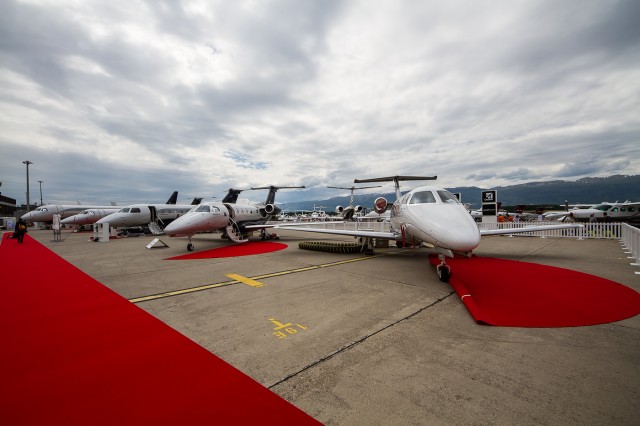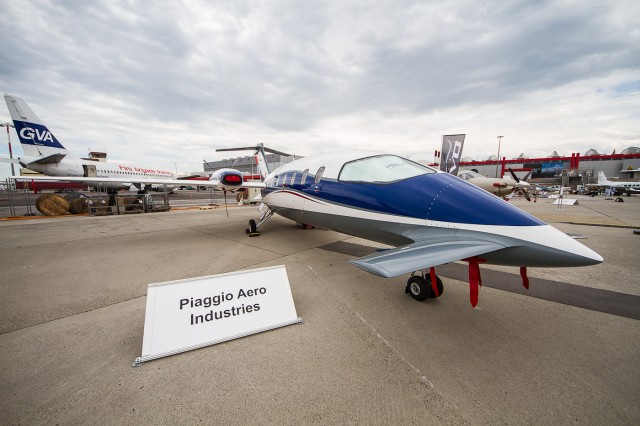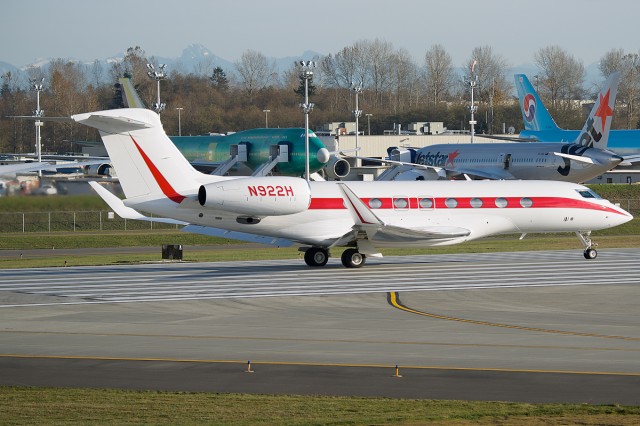
A total of 56 aircraft were p-resent at the EBACE 2014 static display Photo: Jacob Pfleger | AirlineReporter
In part 1 of my EBACE coverage I provided a brief background and some news from the event. This installment will cover the aircraft static display — and they were impressive.
There was a total of 56 aircraft on display, ranging from large airliner-type business aircraft such as the BBJ and Airbus A319CJ, right through to Very Light Jet (VLJ) models such as the Eclipse 500.

Both the Big and Small such as this Piaggio Avanti were on display Photo: Jacob Pfleger | AirlineReporter
Although there were the same amount of aircraft as last year at the static display, I did find last year’s show to have greater variety of aircraft than this year. Even so, this year’s display did not disappoint.
Most of the aircraft on display are generally offered for sale or charter, and of the 10 aircraft I viewed, at least three or four had already been sold at the show. This illustrates the importance of a static display; not just to please us AvGeeks, but also as a strategic selling point of the aircraft – think of it like a super luxury outdoor car lot.

Honeywell’s mint-condition Gulfstream G650 departing KPAE – Photo: Bernie Leighton | AirlineReporter
Last year, I wrote about visiting Honeywell’s facility in Redmond, after which I got to spend an afternoon flying with their crash test dummies. That, however, only covers the activities of Honeywell Aerospace in Washington State.
Honeywell has a large presence in Phoenix, specifically at Deer Valley Airport. At one point this was the legacy of Sperry Electronics, which got its start making gyroscopes for Curtiss biplanes. They even had a rudimentary autopilot demonstration in June, 1914.
So, what does this have to do with Honeywell? Well, prior to their purchase by Honeywell Aerospace, Sperry developed the first Flight Management Computers (FMC). The best way to describe an FMC is that it’s a layer above the autopilot and allows for a degree of pre-planning and programming for the aircraft’s mission. Flight Management Computers have evolved to a level most of the old Sperry guard could never have imagined, though the form factor has remained relatively the same.
Honeywell Aerospace is not known for sitting still. Much of their avionics technology hangs out on the bleeding edge. The thing is, airlines and their associated airframers tend to demand low cost AND reliability. Flight deck and avionics design usually evolves within corporate aviation. It is no wonder, then, that Honeywell and Gulfstream work so closely to develop an integrated flight deck and avionics suite. The internal name of the Honeywell avionics and flight management package is Primus Epic.
While it is also at home on a Falcon 7X, Dassault puts their own special finishing touches on it so that it better matches their ecosystem. We’re not talking about Dassault today- we’re discussing Gulfstream- so the Honeywell system is marketed as PlaneView.
How does one get a good understanding of the practical elements of PlaneView/Primus Epic you ask?
The best way. By seeing it in person by flying on a Gulfstream G650 and who am I to say no?


